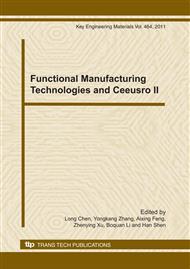p.264
p.268
p.272
p.279
p.285
p.289
p.293
p.299
p.304
Modal Analysis of Ball Screw Drive System by Finite Element Method
Abstract:
Due to raising ability of five-axis CNC machine tools to machine geometrically complex work pieces efficiently and with higher dimensional accuracy, it is necessary to research its mechanical eigenfrequence of mechanical transmission system. Considering the CNC machine tool’s work table runs slowly and has little damp, the system is considered as an invariable system and the whole system is nearly taken as structure in place of mechanism into account; The Finite Element method(FEM) in ANSYS software is presented in this paper to be used for the solution of the modal analysis of screw drive system for CNC machine, an FEM structural model in ANSYS for the system is developed to estimate the modal characteristics effectively and properly here, the results illuminate that vibration forms of the system and the proportional Gain factor in the position control of CNC drive system is estimated.
Info:
Periodical:
Pages:
285-288
Citation:
Online since:
January 2011
Authors:
Price:
Сopyright:
© 2011 Trans Tech Publications Ltd. All Rights Reserved
Share:
Citation:


